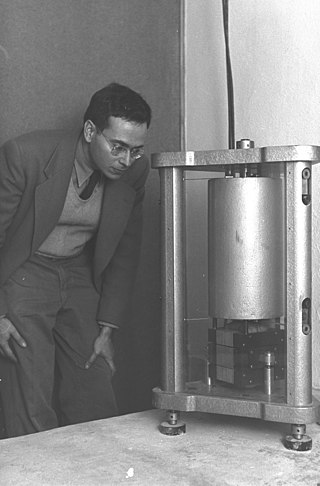Related Research Articles

An earthquake is the shaking of the surface of the Earth resulting from a sudden release of energy in the Earth's lithosphere that creates seismic waves. Earthquakes can range in intensity, from those that are so weak that they cannot be felt, to those violent enough to propel objects and people into the air, damage critical infrastructure, and wreak destruction across entire cities. The seismic activity of an area is the frequency, type, and size of earthquakes experienced over a particular time. The seismicity at a particular location in the Earth is the average rate of seismic energy release per unit volume. The word tremor is also used for non-earthquake seismic rumbling.

Earthquakes are caused by movements within the Earth's crust and uppermost mantle. They range from events too weak to be detectable except by sensitive instrumentation, to sudden and violent events lasting many minutes which have caused some of the greatest disasters in human history. Below, earthquakes are listed by period, region or country, year, magnitude, cost, fatalities and number of scientific studies.
Earthquake prediction is a branch of the science of seismology concerned with the specification of the time, location, and magnitude of future earthquakes within stated limits, and particularly "the determination of parameters for the next strong earthquake to occur in a region". Earthquake prediction is sometimes distinguished from earthquake forecasting, which can be defined as the probabilistic assessment of general earthquake hazard, including the frequency and magnitude of damaging earthquakes in a given area over years or decades. Not all scientists distinguish "prediction" and "forecast", but the distinction is useful.

Frank Press was an American geophysicist. He was an advisor to four U.S. presidents, and later served two consecutive terms as president of the U.S. National Academy of Sciences (1981–1993). He was the author of 160 scientific papers and co-author of the textbooks Earth and Understanding Earth.

Vladimir Isaacovich Keilis-Borok was a Russian mathematical geophysicist and seismologist.

The New Madrid Seismic Zone, sometimes called the New Madrid Fault Line, is a major seismic zone and a prolific source of intraplate earthquakes in the Southern and Midwestern United States, stretching to the southwest from New Madrid, Missouri.

An active fault is a fault that is likely to become the source of another earthquake sometime in the future. Geologists commonly consider faults to be active if there has been movement observed or evidence of seismic activity during the last 10,000 years.

David Alexander Johnston was an American United States Geological Survey (USGS) volcanologist who was killed by the 1980 eruption of Mount St. Helens in the U.S. state of Washington. A principal scientist on the USGS monitoring team, Johnston was killed in the eruption while manning an observation post six miles (10 km) away on the morning of May 18, 1980. He was the first to report the eruption, transmitting "Vancouver! Vancouver! This is it!" before he was swept away by a lateral blast; despite a thorough search, Johnston's body was never found, but state highway workers discovered remnants of his USGS trailer in 1993.

The Defense Science Board (DSB) is a committee of civilian experts appointed to advise the U.S. Department of Defense on scientific and technical matters. It was established in 1956 on the second Hoover Commission's recommendation.

Chengdu University of Technology is a national public research university located in Chengdu, Sichuan, China. It is a technology-focused institution co-sponsored by the Ministry of Education of China, the Ministry of Natural Resources of China, and the Government of Sichuan Province.

Iben Browning was an American business consultant, author, and "self-proclaimed climatologist." He is most notable for having made various failed predictions of disasters involving climate, volcanoes, earthquakes, and government collapse.

The China Geological Survey (CGS) (Chinese: 中国地质调查局) is a government-owned, not-for-profit, Chinese organization researching China's mineral resources. It is a public institution managed by the State Council's ministries and commissions responsible for geological and mineral exploration under the State Council of the People's Republic of China. According to the national land and resources survey plan, it is now managed by the Ministry of Natural Resources. It is the largest Geoscience agency in China since being reinstated in 1999, and the headquarter is in Beijing, the capital of China.
The California Earthquake Prediction Evaluation Council (CEPEC) is a committee of earthquake experts that reviews potentially credible earthquake predictions and forecasts. Its purpose is to advise the Governor of California via the California Office of Emergency Services (CalOES).

Marcia Kemper McNutt is an American geophysicist and the 22nd president of the National Academy of Sciences (NAS) of the United States. Previously, she served as editor-in-chief of the peer-reviewed journal Science from 2013 to 2016. McNutt holds a visiting appointment at the Scripps Institution of Oceanography. She is a member of the National Academies of Sciences, Engineering, and Medicine advisory committee for the Division on Earth and Life Studies and the Forum on Open Science. McNutt chaired the NASEM climate intervention committee who delivered two reports in 2015.

Lucile M. Jones is a seismologist and public voice for earthquake science and earthquake safety in California. One of the foremost and trusted public authorities on earthquakes, Jones is viewed by many in Southern California as "the Beyoncé of earthquakes" who is frequently called up on to provide information on recent earthquakes.
The 2004 re-authorization of National Earthquake Hazards Reduction Program (NEHRP) directed that the Director of the U.S. National Institute of Standards and Technology (NIST) establish the Advisory Committee on Earthquake Hazards Reduction (ACEHR) to assess:

Walter Curran Mendenhall, was the fifth director of the US Geological Survey.

The United States Geological Survey (USGS), founded as the Geological Survey, is an agency of the United States government whose work spans the disciplines of biology, geography, geology, and hydrology. The agency was founded on March 3, 1879, to study the landscape of the United States, its natural resources, and the natural hazards that threaten it. The agency also makes maps of extraterrestrial planets and moons based on data from U.S. space probes.

The Coordinating Committee for Earthquake Prediction (CCEP) in Japan was founded in April 1969, as part of the Geodesy Council's Second Earthquake Prediction Plan, in order to carry out a comprehensive evaluation of earthquake data in Japan. The committee consists of 30 members and meets four times each year, as well as publishing a report on its activities twice each year. The CCEP brings together representatives from 20 governmental bodies and universities engaged in earthquake prediction and research. It has a secretariat within the Ministry of Land, Infrastructure, Transport and Tourism.

Earthquake Hazards Reduction Act of 1977 is a statute formulating a national policy to diminish the perils of earthquakes in the United States. The Act of Congress is a declaration for an earthquake prediction system, national earthquake hazards reduction program, and seismological research studies. The United States public law authorizes States assistance through the provisions of the Disaster Relief Act of 1974.